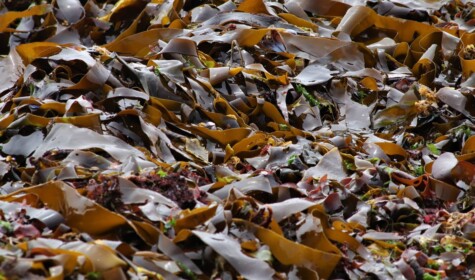With industrial land-based agriculture becoming untenable in its environmental destruction and vulnerabilities to climate change, and overfishing decimating many fish species, new options to feed current and growing populations that are both sustainable and nutritious are being explored. Some suggest, that despite the depletion of fish stocks, the answer lies in the world’s oceans – in what seaweed offers. Fast proving itself as a viable, diverse, healthy oceanic food source with great potential to ameliorate some of these issues, seaweed’s status is gaining momentum. Hailed by many as the ‘new superfood’ and saviour of the oceans due to its ability to combat ocean acidification, seaweed is garnering a lot of interest. No more so than in Australia with its endless coastline and with Southern Australia having the highest biodiversity of seaweed in the world, its value as an important food source, fertilizer, and ability to impact the environment positively is just being discovered.
As the consequences of the industrial food system mount and environmental and public health degradation intensifies, the disconnect between diet and environment can no longer be ignored. The consumption trends of the western diet, high in animal based-foods, protein, refined carbohydrates, fats and sugars is causing havoc on health. This has resulted in the steep rise of diet-related chronic diseases characterised by over nutrition and noncommunicable diseases such as type 2 diabetes, stroke, cancer and obesity, coupled with micronutrient deficiencies due to the poor nutritional content of processed foods. This, along with the production practices of the industrial food system which are the leading cause of global biodiversity loss, ecological destruction and a significant contributor to greenhouse gas emissions, has seen diet and the environment subject to a range of negative impacts and led to repeated calls to make diets more sustainable.
Although seaweed is often overlooked and dismissed in the West, its role in the evolution of humanity spans as far back as 21,000 BC, where recent excavations in Monte Verde, Chile, have revealed seaweed was used by coastal peoples as a food source. Historically, seaweed has had great cultural significance to indigenous societies across South America, Asia, Polynesia, Australia and New Zealand not only as a food source, but also medicinally and in technological applications such as fishing lines and building materials. It has also been hypothesised that seaweed played a direct role in making humans who we are today, by providing the essential nutrients, in particular magnesium and zinc, to increase our brain size and its development. This forgotten resource is being rediscovered not only as a nutritious food source but for its ecological sustainability and prospective ability in combating climate change as a carbon sink.
Diversity and Nutritional Value Of Seaweed
Seaweed is a marine form of red, brown and green algae that grows at incredible rates, in all of the earth’s coastal climatic zones. It comes in a multitude of species, colours, textures, shapes and flavours, such as wakame, kombu and nori, to name a few. Nearly all are available for human consumption.
Depending on the species, where it is grown, and in which season it is picked, seaweeds are highly nutritious and generally contain high amounts of iodine, protein, omega-3 fatty acids, B12 and vital minerals such as calcium, potassium, magnesium and iron. Omega-3 fatty acids are essential to the development of the human brain and research has shown that it helps prevent mental illness, coronary heart disease and cancer. Seaweed provides a direct source of this essential fatty acid, making it possible to relieve pressure on fish stocks if consumers were more educated on the benefits and taste of seaweed, along with the sustainability problems associated with wild catch fish and the farming of high trophic fish species. Another major benefit of seaweed that directly relates to human health is its high naturally occurring iodine content. As the World Health Organisation points out “iodine deficiency disorders…[are] the world’s most prevalent, yet easily preventable, cause of brain damage”. It is estimated that over 200 million people are at risk of iodine deficiency which is a result of iodine poor soil, drinking water and food. Although many countries have made it compulsory to add iodine to common table salt, many more have not, and incorporating small amounts of seaweed into diets could contribute significantly to improving this micronutrient deficiency as well as increasing overall nutrition.
Dr Pia Windberg, an Australian marine ecologist who recognised the importance of seaweed’s nutritional composition and the important role it could play in human health and diet, set up a company, PhycoHealth, in order to promote and produce locally sourced seaweed products such as pasta, muesli and salt, which are highly nutritious. Dr Windberg’s efforts to educate people on the benefits of seaweed and promote seaweed consumption has also seen her partner up with Australian chefs in order to innovate using various species of seaweeds to enhance dishes in restaurants as well as publishing a cookbook dedicated to seaweed. Only a small amount is recommended for daily consumption, as overconsumption can result in too much iodine intake potentially leading to thyroid problems, and if seaweed is not sourced from clean waters, environmental toxins and heavy metals can be present. Seaweed as a food source is more of a side-dish or ingredient rather than a meal in itself. Through the efforts of people like Dr Windberg and creative chefs, seaweed is becoming more commonly encountered on Australian tables transforming peoples’ experiences and perceptions of seaweed from a slimy smelly decaying marine plant into a delicious, beautiful and intriguing new food.
Environmental Value
Beyond being a highly nutritional food source, environmentally, seaweed production is the most benign form of aquaculture, requiring very little infrastructure, no inputs and having an exceptionally quick growth rate. Seaweed is reliant on inorganic nutrients such as phosphorus and nitrogen in water for it to grow, which agricultural run-off, fish farms and sewage facilities provide. Due to this, seaweed farming is viewed as ecologically sustainable and beneficial because of its inherent positive environmental characteristics, such as its ability to add oxygen to water and filter seawater of excess nutrients, offering solutions to such problems as terrestrial agricultural run-off which in the current climate of environmental degradation is enthusiastically being explored.
One such positive attribute of seaweed is already being utilized in Australia by its incorporation into a commercial aquaculture farm providing a sustainable solution to waste water. Pacific Reef Fisheries in Queensland is using seaweed to filter its fish farm waste to produce clean waste water. The numerous nutrients in the waste water are also used to grow seaweed which is then processed into fertiliser in the form of biochar. This integrative multi-trophic system addresses one negative aspect of aquaculture, along with producing an environmental friendly product. Through such a system, seaweed is indirectly playing a role in producing sustainable seafood for future food security.
Another significant finding to have emerged from a study by researchers at James Cook University in Queensland, Australia, in collaboration with the Commonwealth Scientific and Industrial Research Organization (CSIRO), is that by adding only 2% of dried seaweed to the diet of cows, methane emissions from cows are reduced by 99%. This incredible finding, means that the cattle industry’s carbon footprint could be drastically reduced, which is welcome news given its current levels.
One of the most exciting future applications of seaweed, as discussed by the Australian scientist Tim Flannery, is the ability of seaweed to reduce ocean acidification by acting as a carbon sink. Seaweed’s efficiency in absorbing CO2 from the atmosphere is impressive. Flannery estimates that if 9% of the oceans were covered in seaweed farms it would be enough to absorb all human emissions. Although this idea requires further extensive research and technical solutions in order to test its viability and ecological safety on such a large scale, it is seaweed’s untapped attributes in providing part of a solution for mitigating climate change that is driving great interest and investment.
With such beneficial uses, offering viable solutions that span nutrition, health – both for humans and the environment – along with sustainable industry applications, it is no wonder that such hype surrounds seaweed. Nevertheless, as with all emerging industries, it is important to tread cautiously in order not to cause any unforeseen ecological harm. It is unclear how large-scale farming of seaweed might interact with other marine ecosystems and what the long-term impacts of monoculture seaweed farming might be. For the moment, however, it appears there is good reason to make note of this humble marine plant and for it to be recognised as something filled with unrealized potential and bursting with flavour.



